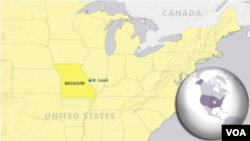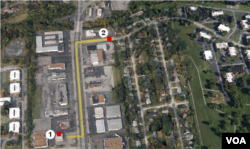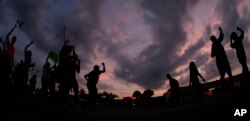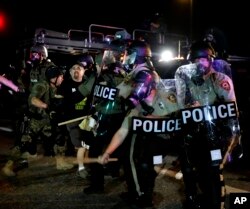When a white policeman fatally shot unarmed black teenager Michael Brown in a street confrontation last summer, the outrage reverberated far beyond the central U.S. town of Ferguson, Missouri.
That August 9 shooting — along with later police-related deaths of African-Americans in other communities — has sharpened the nation’s focus on racial inequities and forced a re-examination of its law enforcement practices.
"Ferguson was a spark for a larger play which is now a brushfire in America," said Jeffrey McCune, a professor studying race and gender at Washington University in nearby St. Louis.
"You have all these organizations across the country resisting,” he told the French news agency AFP, “advancing the cause of black people and black liberation and reducing the amount of violence that black men and women face."
This weekend, Ferguson — a predominantly black St. Louis suburb of 21,000 — is holding marches to mark the anniversary.
“It’s not so much a happy moment” because it recognizes the loss of “a brother,” Rasheen Aldridge, 21, of Ferguson, told VOA.
But he said the activism provoked by Brown’s death “has brought a lot of positive change, a lot of positive energy — not only to Ferguson but to the whole region.”
For weeks after Brown's shooting, demonstrators, sometimes violent, had demanded a reckoning. When a grand jury in late November found insufficient cause to indict Officer Darren Wilson, protests erupted in more than 170 U.S. cities, from Atlanta to New York to Seattle to Washington.
In March, the U.S. Justice Department announced it would not pursue civil rights charges against the officer.
But the department also said a separate investigation into Ferguson showed extensive evidence of a police force operating with extreme racial prejudice and a municipal court system exploiting blacks to generate city revenue.
Since then, Ferguson has installed a new police chief, city manager and municipal judge — all black.. Their predecessors were white.
The city has stepped up recruitment of minority officers, who now account for five of its 50-member force, and it’s setting up a citizen police review board, the Associated Press said.
The reforms implemented in Ferguson policing and city management have reduced traffic stops and fines — and trimmed its revenue by nearly $700,000 in the first six months this year, the AP said, citing a city finance report.
“We’re not done yet” with changes, said Aldridge, the youngest member of the Ferguson Commission.
The independent panel's mission is to help chart a path to improve the region's social and economic conditions. The commission recently endorsed more tactical, anti-bias and wellness training for police, and Aldridge said it's looking at measures such as raising the minimum wage and establishing childhood savings accounts to support education.
“This is just the beginning of more improvements to our community, more improvements to police,” he told VOA.
The questionable deaths of African-Americans in Ferguson, New York, Cleveland, Baltimore and other cities have amplified a movement — begun with the 2012 death of Trayvon Martin in Florida — declaring that “Black Lives Matter.”
The United States needs to do more to achieve racial equality, according to a new poll by the Pew Research Center, a nonpartisan “fact tank” in Washington.
It found half of all Americans consider racism a big problem and another third say it’s somewhat problematic. Only 4 percent say they see no problem. Nonwhites are more likely to acknowledge racism as an issue. That’s the case for 73 percent of African-Americans, compared with 58 percent of Hispanics and 44 percent of whites.
“Still, significant divides remain on these questions, with Republicans less likely than Democrats to hold these views,” Pew found. It polled 2,002 adults July 14-20.
Nationally, African-Americans are arrested at much higher rates than people of other races, USA Today discovered in an analysis of FBI data last year. It found that while blacks in Ferguson were almost three times as likely to be arrested as people of other races, nearly 1,600 other U.S. communities had even higher rates.
Dismayed by such data, President Barack Obama in December announced the President’s Task Force on 21st Century Policing.
Its final report, issued in May, calls for building trust “on both sides of the police/citizen divide.” Among other things, it urges establishing “a culture of transparency and accountability” and collaborating with community residents to identify problems and solutions.
It urges setting standards for the use of new technology, including the body cameras increasingly worn by officers to document interactions with the public.
Also in May, the White House announced it would halt funding of some military-style equipment for law enforcement.
The federal restrictions cover Humvees and other wheeled armored vehicles, specialized firearms, explosives and some riot gear — equipment that some critics said escalated tensions at the scene of demonstrations.
But the National Association of Police Organizations’ executive director, William Johnson, says the restrictions are just the latest in a series of setbacks to law enforcement in light of police shootings.
“People don’t like how certain equipment looks,” Johnson said. He complained that the decision also restricts helmets and shields that law enforcement personnel wear “to protect themselves.”
Johnson, a former police officer and prosecutor, said police morale is at the lowest level he’s seen since joining the organization in 1985.
“Officers feel that they’re under siege, that they’re unfairly criticized, that they’re painted with a very broad brush for the sins or omissions of a few,” he said, naming Obama and his former attorney general, Eric Holder, among the antagonists.
Johnson said criticism breeds the kind of anti-police sentiment that led a gunman to ambush and fatally shoot New York Police Department Officers Wenjian Liu and Rafael Ramos in their patrol car in December. He also said a hostile environment discourages police recruitment — even in families that have produced generations of cops.
“The danger, the risk — that’s always been there,” Johnson said. Now “there’s just so much more on the plates than there was 15 years ago, [with] the specter of terrorist attacks and drug gangs ... and yet we are fewer people on patrol than we did in 2001.”
In Ferguson, Officer Jill Gronewald, who started with the police force just weeks after Brown's death, is trying to build connections within the community.
"The protesters hate this uniform no matter who's in it," she told CNN. "Am I aware color exists? Absolutely. But when I go out there, I don't see color. There is a perception we are not listening. But we are."
The Associated Press and AFP contributed to this report.



